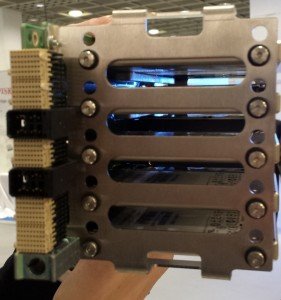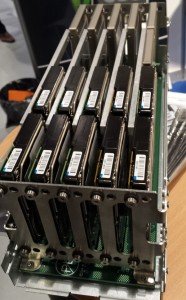This post is also available in: Italian
Reading Time: 5 minutesDuring the first European Tech Field Day Extra (at VMworld EU in Barcelona) the first company that we met was X-IO Technologies. As written in a previous post, X-IO has a long term (over two decades with different names) of expertise to deliver unmatched price/performance for enterprise applications.
It’s all started in 1999 with Seagate Technologies with the idea of build a new zero touch design storage: Seagate invested over $100 million in this project, but on 2007 this technology was acquired by Xiotech (in 2007) and Intellinget Storage Element (ISE) has began is life on 2008.
There were Gavin McLaughlin (VP of Worldwide Marketing) and Hollis Beall (Director of Technical Marketing).
 X-IO Technologies is located in Colorado Springs, in the same building where the company was originally founded in back in 2002.
X-IO Technologies is located in Colorado Springs, in the same building where the company was originally founded in back in 2002.
In the first part Gavin McLaughlin has introduced the main concepts adopted by X-IO and their products.
The X-IO Intelligent Storage Element (ISE) is available in all-HDD variants, ISE 200 Series, and hybrid variants – the ISE 700 series. The X-IO array is based on ISE software which itself is based on a Linux microkernel running on each Controller.
Each system is based on a 3U chassis with two MRC IO controllers and two DataPacks on a SAS backplane capable of supporting up to 40 disks.
It’s curios that there is still the place for somebody that are thinking different: in a world where most storage are based on commodity hardware is still possible engineer a solution tuned both in the software but also in hardware.
And the optimizations bring the results: 400-600 IOPs from a 10kRPM drive by using special firmware (and the special X-IO architecture). Really a lot making the spindles still interesting (in a world where somebody is moving to 100% flash solution).
The DataPack is an example: not only one disk on a rail, but more disks in a single optimized block:
Note that the datapack is also used for SSD disk, and a single system can contain also datapacks with different disk size.
VMware integration is tight and some functions (like thin provisioning) are completly demanted to the virtualization layer, other (like replication) are provided by the ISE. This blog describe the VMware functions supported by X-IO:
- VMware VAAI primitives: zero detect, xcopy & ATS but no UNMAP as there is no Thin Provisioning in the array.
- VMware VASA provider 1.0
- VMware Virtual Volume (VASA 2.0) is in the roadmap
- VMware vCloud Automation Center
- VMware vCenter Orchestrator
- VMware vCenter Operations Manager (actually only 5.8 version, but in the roadmap there is the vRealize version)
- RDP – Rapid Desktop Program, Certification for Horizon View
- ISE Manager Suite– VMware Ecosystem Integration
- Management Pack for VMware vCenter Operations
- VMware Web Client plug-in (and also a plug-in for the legacy client)
For the storage replication aspects is possible have syncronous replication and “metro-cluster” with source and target LUNs both active.
Then the VDI was used as a typical user case for this kind of product and was really interesting the technical an scientific approach to it by defining the required IOPS in several cases (in the example of 1500 destkops):
- Normal operation = 8000 IOPS
- Login storm: 10000 to 15000 IOPS
- Deploy/recompose: 15000 to 25000 IOPS
- Boot storm: 40000 to 50000 IOPS
Hollis Beall, Director of Technical Marketing, has discussed about the X-IO Storage VDI testing numbers and discusses the overall product architecture and technologies.
Login VSI was used as a benchmark tool in order to demonstrate the effectiveness of this solution in VDI environments. And they also have a partnership with Cisco for the X-Pod for VDI build with X-IO and Cisco UCS and VMware Horizon View.
Following on from Tech Field Day at VMworld Europe, there is also a new company blog post from Hollis Beall entitled: Running a VDI Pilot To Make Sure Your First is a Success.
See also:
- X-IO Presents at Tech Field Day Extra at VMworld Europe 2014
- X-IO: Zero Maintenance, Low Latency VDI Storage
- Running a VDI Pilot To Make Sure Your First is a Success
- VMworld EU 2013 Report – X-IO
Disclaimer: I’ve been invited to this event by Gestalt IT, but I’m not compensated for my time and I’m not obliged to blog. Furthermore, the content is not reviewed, approved or published by any other person than me.





